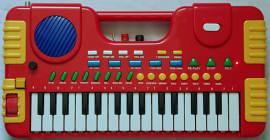 |
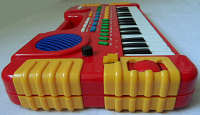 |
|
 |
 |
Unfortunately a severe chip design flaw in this instrument prevents proper play of 2 note polyphonic music. (A close variant without this flaw is My Song Maker.) When modified, you can get really bizarre tekkno sounds out of it, but don't be confused by the term "synthesizer" on the box; this thing has no user programmable sounds or anything similarly fancy, but only each 8 fixed OBS preset sounds and rhythms. The percussion is made from very boring lo-fi samples, but the drumpad buttons can be also switched to 4 animal voice samples.
My specimen has the brand name Mega, but also other versions may exist. In the year 2000 on Asian Sources the Hong Kong company Hundred Power Industries Limited offered this tablehooter with the internal name HP-98. (The 98 may hint to the initial release year.) My Music Center was one of the most widespread toy keyboards ever made, and it was also released in a zillion of other, partly very different looking case variants. In late 1990th there even was a time when about 2/3 of all toy keyboards with rhythm on the market contained exactly this hardware. Compared to established keyboard brands it was often dirt cheap. So in Germany in Turkish import shops you could find these for 10DM (new on fleamarkets even 5 DM) while (if I remember well) a Casio SA-2 as their cheapest toy was near 30DM.
The sound hardware of My Music Center so has set the base of a large hardware family of other complex toy keyboards those often have more features or less flaws, but many of these have other restrictions or boring sounds, thus the quirky original is still interesting. Nowadays it has become a classic by itself.
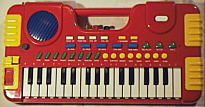 |
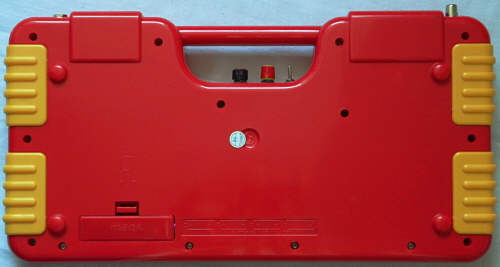 |
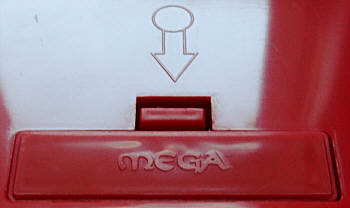 |
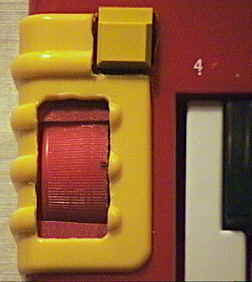 |
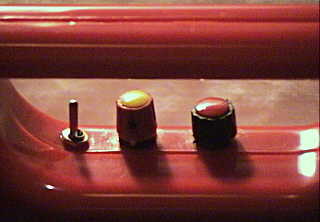 |
Here you see the pitchbend controls and speaker mute switch added by me. |
Attention: There are several different My Music Center versions with almost the same case but different CPU and thus different sounds and demos. E.g. there is one with the sound hardware of Musical Centre, which has different sound and rhythm names. The original (and most widespread?) My Music Center that I described here plays no start-up jingle after power on and button presses play without rhythm a quiet hihat noise while most others play a short beep or with OBS preset sound buttons the corresponding sound.
All preset sounds have a volume envelope with well audible ticking zipper noise and contain a chorus effect with slow tremolo. They all have short sustain, thus no very short blipping notes can be played, but great is that the sounds of My Music Center (and most of its variants) can be time dynamically played, i.e. in preset sounds with slow (non- percussive) attack you can play quieter notes by pressing a key very short, because this prevents the attack phase to reach full volume and instead directly goes into the release phase, which makes the sustain of the note start at lower volume. Especially the "trumpet", "guitar" and "music box" sound very unique, harsh and digitallic. Especially the high notes of the "trumpet" have very strong DAC aliasing noises those produce disharmonic overtones similar like a ring modulator. The "guitar" sounds like a cross between sitar and banjo and has a very strange and buzzy, wire- like roaring bass range. The "mandolin" rings with 8Hz and the percussive attack changes its timbre in a strange way, which makes the sound very unique; when 2 notes play simultaneously, the ring of both voices can have different phases. The "bell" is rather a vibraphone and the "organ" is more a harsh accordion; "violin" is similar but duller and has slow attack. The piano in the opposite sounds even more realistic (although honkytonk- like) than the one of many early non- toy keyboards. The "music box" is particularly great for new-age style musics.
Interesting for live play tricks is that the 8 OBS preset sound buttons can also be pressed while keys are held down without stopping their notes. By rhythmically pressing these buttons, this way many strange effects can be created; especially switching to "mandolin" adds the mandolin ringing to the timbre of a currently held note, or switching from "mandolin" to something else quits the ringing. Other changes only affect new notes, this way 2 simultaneous notes with different timbre can be played by holding a key, switching the sound and then pressing a 2nd key. Sometimes this messes up the keyboard in strange ways that some keys keep a different timbre until some other notes are played. Generally the original My Music Center has lots of bizarre sound glitches those make the behaviour a bit unpredictable. The most annoying one is the polyphony bug, which semi- randomly makes a new note truncate a held or still sounding one, which makes polyphonic play almost impossible. (If you don't like this, buy a variant with My Song Maker hardware, which works much better.) During a sustaining preset sound (e.g. "violin") trilling a key a few times sometimes makes the note get stuck and keep playing for 3 seconds; then it stops with a sudden end click. Sometimes a played note randomly lacks the 2nd suboscillator (i.e. no chorus).
The only 4 percussion sounds are boring dull and noisy hissing low- res samples without dynamics. But at least the 4 drumpad buttons can be switched to animal voices, those growl nicely when pitched down by an added pitchbend potentiometer. With rhythm the main voice plays only monophonic. The rhythm patterns are partly quite long but nothing spectacular. Nice is that the OBS rhythm patterns immediately (re-)start their pattern and so can be used for live play tricks like fill-ins. (Unlike many successors, the original My Music Center does not reset tempo by this.)
The monophonic record/ playback sequencer is quite useless because it
looses its contents when anything but "re-play" is pressed. (Playing notes
or drumpads delete and overwrite the sequence.) At least it records also
drumpad events and you can immediately restart the sequence (make it rhythmically
stutter) by pressing "re-play" again. You can also during playback switch
the preset sound, the tempo and the mode of the recorded drumpad events
(drums or animal), but that's all. Pressing "drum/animal" toggles recorded
drumpad into the corresponding animal sounds.
circuit bending detailsThe "My Music Center" is a cost effective construction with a fairly empty PCB. The CPU is a single chip COB module that in my original version is marked "Inovus IA371, PCB 952", however the many clones may have COBs with different shape and naming. The CPU clock rate is DC controlled by a resistor and so can be easily manipulated by installing potentiometers or sensor contacts.
Holtek - Ad-lib Micro®In late 1990th this microcontroller series became extremely popular in cheap no-name single-chip keyboards and sound toys, and likely also caused the almost demise of quality brand (Casio, Yamaha, Kawai) toy- and mini keyboard sales. The impact can be almost compared with the videogame market crash of 1983. Despite the timbre quality of the flood of Chinese toy tablehooters was lower than in-house developed chips of the classic quality brands (and many had other flaws), they were simply very much cheaper. So finally even Casio tried to sell such a rebranded piece of cheap awful sounding junk as MA-150/MA-170, and today Bontempi still offers a mix of rebranded Chinese toy tablehooters and own higher quality models. Also Holtek later made reasonable sounding digital keyboard CPUs based on sufficiently high resolution samples, and nowadays of course also other companies make them; but what it began with was the Ad-lib Micro. With multitimbrale polyphonic melody voices, samples, accompaniment and demos it was the first cheap single-chip microcontroller intended to compete e.g. with Casio SA-series, despite Casio's 4 bit softsynth CPU of 1989 was much more powerful (21.725 MHz, about 55.7KB DRAM, 63.5KB sample ROM+14KB program ROM according to patents). Unfortunately nobody spent time to program similarly complex sounds on the Ad-lib Micro, which makes it a bit boring. But among toy-grade keyboards it had the last genuinely novel sound synthesis engine, which timbre was still majorly defined by hardware constraints and not only by programmer's choice of sampled waveforms.Several versions of this Taiwanese lo-fi synth chip exists, those mainly differ in polyphony and amount of memory, but the general sound engine with "ETS" (Electronical Tone Synthesizer) 7 bit static waveform ADSR synth and dedicated PCM voice (percussion) channels of compressed 5 bit samples stays the same. The sound is output through an 8 bit time slice DAC with characteristic glassy timbre. In many instruments for each melody voice 2 detuned ETS channels are layered in software as a (often stereo) chorus effect, which halves polyphony. The datasheets looks detailed enough to emulate this thing if anybody finds a method to dump the rom. ETS channels have 8 static waveforms of 7 bit with 64 steps and ADSR envelope with 4 bit parameter resolution, sustain & vibrato. PCM channels (intended for percussion and effect noises, not main voice) use 5 bit samples with 8 to 5 µ-law compression, but sample rate can be only set for all channels together with coarse frequency resolution. The 8 bit CPU has only 96 byte RAM. The intended clock rate is 3.58 MHz (but can be overclocked higher - it is unknown if also keyboard manufacturers did this). HT3630
HT3650
HT3670
HT3690
Software variants of these are named with a suffix letter. In the official Holtek forum I read that of the HT36 chip series exists no OTP (prom) version, so normal ones contain mask rom, which will be good news for long term stability and safer circuit-bending, since mask rom does not suffer of bitrot and can not be accidentally overwritten by messing with wrong pins. For hardware developers apparently there is a development board "HT36DB", and of the (newer) "Music MCU" HT36B0 exists a flash version HT36P03 that can be written with a "HT-C300 Flash Writer". The caption mentioned "Music Studio HT36", which may be the name of a development software. But this is all I know. I am not their developer and haven't seen any of this. differencesBy internal polyphony and volume control, the "My Music Center" CPU is likely a variant of Holtek HT3670. I found no datasheet of it, so it was likely a custom version. Holtek published some datasheets of in-house example versions (e.g. as advertisement to bait keyboard manufacturers), but in their component list many other ICs are marked "restricted" (i.e. confidential) because 3rd party manufacturers can order custom software variants of ICs and keep datasheets secret as advantage over competitors. (However upon a time the original "My Music Center" CPU was such widespread that it was obviously offered to many different keyboard companies.)Another company that makes blatantly similar toy keyboard CPUs is Nyquest, so it may be that unidentified variants stem from there. E.g. in a datasheet of 2015 their CPU "NY5B025B-002" (21 pad COB) has very similar functions (animal voice-, sound- and most rhythm names) like My Music Center, although die layout and pinout details differ (e.g. clock rate 1 MHz, only 13 tempo steps, internal PWM speaker driver). I don't know what they sound like. Nowadays Holtek does not seem to offer the Ad-lib Micro series anymore. Successor are their "Music Synthesizer 8-Bit MCU" chips (named like "HT36"+letter+cipher, e.g. "HT36A2" in Yongmei DL2300) those may be found from toy- to big fullsize generic midi and USB home keyboards. But these are fully sample based common modern stuff with 16 bit DAC and have no special grainy lo-fi synth timbres anymore. Despite the HT3670 has 3 DAC output pins (stereo + percussion), the My Music Center CPU "IA371" only has one, thus they were either internally bonded together inside the COB or an undocumented simplified version exists. Also clock in HT3670 does not seem to be DC controlled and there are pin order differences to the COB, so I conclude that the chip version is indeed physically different. By shitshot also 2 PCM channels can play samples at different pitch, which contradicts Ad-lib Micro. Another oddity is that with rhythm the main voice turns monophonic despite ETS and PCM channels are technically separate and drumpad sounds indeed do not truncate notes. (Also 2 drumpads can sound simultaneously.) This makes me conclude that the CPU is too slow or otherwise runs out of resources (RAM?) to handle rhythm or sequencer and polyphonic play at the same time. sound generatorThe My Music Center sound hardware employs a special kind of cheap DAC that causes its characteristic glassy timbre. The output needs to be filtered by a capacitor, so I first expected it to be pulse width modulation (PWM bitstream), but closer analysis with analogue oscilloscope revealed that it is in fact a time slice DAC that alternatingly switches through all internal polyphony channels (producing a comb-shaped signal of their amplitudes) those are summed up by a capacitor to avoid additional higher DAC bit hardware. The same principle was successfully used by Yamaha in all kinds of cheap and medium grade sound IC without causing poor timbre quality; the big difference is that in My Music Center the switching frequency is way too slow (possibly even by design to reduce RF emission) and so intermodulates high notes with quite extreme aliasing distortion.The DAC in CPU "IA371" outputs an analogue signal with 4 time slots
for the 4 ETS channels; the 2 PCM channels are layered with them and thus
occupy no additional time slots. The volume envelopes are 4 bit (15 steps),
causing audible zipper noise. The 8 step master volume control pulls the
output signal down (including DC bias level) without reducing bit resolution,
which makes me conclude that it is implemented as a voltage divider (3
resistors pulling against GND) inside the chip.
Interesting is that also the cloned Yamaha DSG in MC-3 and related (earlier?) no-name keyboards by Medeli employed a time slice DAC and geometric waveforms, and that the name "Ad-lib Micro" sounds like an allusion to the Ad-lib PC soundcard (containing Yamaha FM hardware), so there might be other relations between Holtek and Medeli and cloned Yamaha sound generators. Even the clock rate of 3.58 MHz is the same in Medeli and small Yamaha (e.g. PSS-16) FM keyboards, which hints that their frequency dividers may have been copied from Yamaha. keyboard matrixThe keyboard is divided into 4 groups of 8 (octave numbers taken from Casio SA-1). I found no eastereggs, but here it is for comparison. The matrix is scanned unusually slow (affects playability) and makes glitches when overclocked or battery empty. This hints that the scan rate was intentionally reduced to keep parts count low, because the CPU inputs have too high internal resistance to discharge capacitance fast enough. To improve reliability (debounce keys) solder from each of the 8 inputs a 22k pulldown resistor against GND.
The input lines are active-high, i.e. react on +Vs. Any functions can
be triggered by a non- locking switch in series to a diode from one "out"
to one "in" pin.
pitch control & shitshot:
When turning the clock speed very low, the spikes of the comb-shaped
D/A converter output get audible and add more and more bizarre spectral
harmonics to the down pitched sounds the lower it gets turned, until the
sounds turn into series of short bursts of rhythmical bleeps those slowly
change their structure. These textures can e.g. resemble the monotonous
warping background patterns of the song "Broken Head" by Eno, Roedelius
& Moebius. This fascinating effect doesn't exist in normal downsampling
algorithms of PC programs etc., because it stems from the time slice DAC,
that rapidly switches among 4 internal polyphony channels. (Technically
this can be modelled as a very fast running step sequencer with 4 steps
those for each step number enable a corresponding VCA and downpitched audio
playback channel.) That the CPU can be clocked down to zero without crash
hints that it is fully static (i.e. contains no DRAM). Due to in this mode
the keyboard reacts way too slow for playing, the 2nd clock pot can be
set to a normal speed to make the IC recognize key presses by quickly pressing
the yellow button each time a key is changed.
Also the animal voices sound very bizarre and alien-like when pitched down due to the additional harmonics. With the pitch wheel they can even be a sort of "record-scratched" slow and fast; so the frog e.g. turns into a kind of heart beat and the duck into an alien burp when messing around with them. This is very interesting for making a little sinister and dense sounding slow ambient musics. Shitshooting the program by overclocking often results in strange keyboard sounds (e.g. hissy noises). Especially the demo melodies start to play with changed instrumentation; e.g. the PCM drum or animal samples as their main voice (a hardware feature that is never used by normal operation), which proves that internally the CPU control registers for ETS and PCM channels work similar. My added cinch output jack sounds a little muffled by too much bass =>a high pass filter may help. pinout HT3670, IA371?The microcontroller "Holtek HT3670" (40 pin DIL or 41 pad COB) is the "6 Channel Ad-lib Micro" single-chip CPU of many late 1990th polyphonic toy grade keyboards. The "Innovus IA371" (22 pin COB) is the CPU of My Music Center, which appears to be a variant of it. But the die pad order does not really match.In HT3670 ports PA, PB are I/O, ports PC, PD are input-only. In IA371 the internal COB trace 12 is only a stub (connected to pin 18), and there is a bridge from trace 21 to 22 (connected to VDD). Despite trace 15 (pin 14) goes to the COB, it is NC (internally not connected, verified by DMM diode test mode), so the module PCB was likely prepared for an additional matrix pin that is not bonded anywhere. The clock resistor input goes to VDD and is 47k instead of 91k, and supply voltage is +6V instead of the maximum rated 5.2V. So I conclude that the IA371 was an undocumented custom chip version (not only software) with physically different die. This pinout comparison is based on the Holtek HT3670 datasheet of 1997-12-04 (particularly die pad layout) and my own examination of My Music Center. The IA371 keyboard matrix pins are a guess based on the visible COB trace layout and likely wrong. caution: Particularly clock, reset and audio pins don't line
up, thus this table is rather an experimental comparison and does not prove
identity.
|
The 6 demo melodies of this instrument are:
Yes, although it doesn't look so, even this small blue 29 mini- keys tablehooter with its bombastic high- end hifi style logo "SUPERB SOUND - AUDIO PRODUCTS" is indeed based on the original 1st generation My Music Center CPU. Despite this thing features a real 6V power supply jack, it is certainly the absolutely lousiest variant around, because this little squeakbox is so mutilated that everything besides 4 sounds {piano, violin, bell, music box}, 5 rhythms {rock, disco, march, samba, blues}, tempo +/-, the demo button (6 great melodies) and the sequencer was omitted. Instead of the volume +/- buttons it contains a 5 step slide switch (0=mute, thus only 4 steps function), but even at the lowest level it yells so loud and harsh that you fear to get tinitus, and you can always hear the keyboard matrix buzz with constant volume. Even more weird, this thing is only monophonic, and this not because the CPU has no 2nd voice, but simply because the OBS sound buttons were replaced by a 4 step slide switch, which simulates a continuously held down button and thus blocks the keyboard matrix. I really can't imagine why the manufacturer did this; likely its case was initially designed for a different sound hardware (corresponding to the switch layout), and later either the original chip was not available anymore or the manufacturer wanted to make a cheaper or more modern(?) sounding version by mutilating My Music Center circuitry. However, this tablehooter is really crap, and unless you intend to become deaf or make the mankind cry for earwax, don't buy one. There are much better variants of My Music Center around. (Outside the Yongmei hardware class (e.g. Golden Camel 7A), the EK-91DX is definitely a leading candidate in the ranking for the worst keyboards of the world.)
It has only each 4 OBS preset sounds and rhythms and no drumpads. I
don't know the manufacturer of this thing; on the white package box stands
instead of a brand name only "CODE: 98289" and in French the following
address:
| Importateur: EUROPRO S.A
RUE ST. BERNARD 73 1060 BRUSSELS BELGIUM FABRIQUE EN CHINE. |
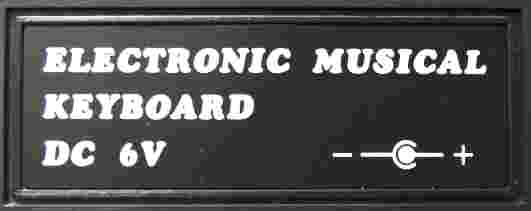 |
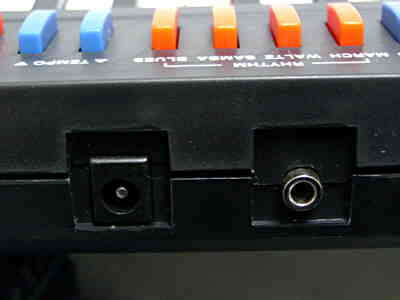 |
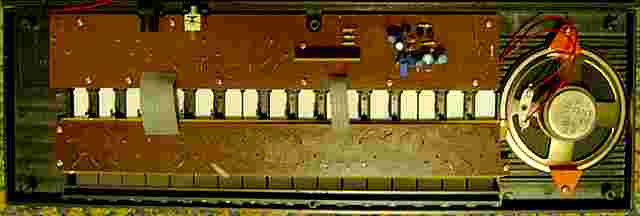 |
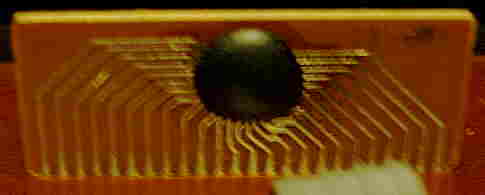 |
 |
 |
| The box shows the brand name StarMate and the keyboard photo
on it has "PITCH" and "VOLUME" embossed below the fake wheels, while the
keyboard itself lacks the writing and only has the brand name RJP
(the company that created the wonderful Ramasio
892). |
According to that manual the obscure MU-798 had these features:
|
Someone claimed in an e-mail that this version really exists (pitchbend range very limited) but didn't tell details.
Likely a predecessor of these was the simple toy keyboard RJP 896
Programmable Guitar Organ (same guitar- shaped case style but only
2 monophonic sounds, pitchbend, vibrato, 10 demos, no rhythm).
In the My Music Center hardware family many other instruments
have been released with differently programmed sounds, behaviour and partly
even higher resolution envelopes and timbres. The likely most complex instrument
based on the classic 4 channel My Music Center sound generator is
the Medeli MC-32 (49 midsize keys).
Particularly interesting are also the bizarre Jin
Xin Toys JX-20165 (with 36 sound variants) and the unique Potex
- Super Jam (with 128 sound variants, 48 keys, slightly different
timbre and warmer bass) and even a keyboard with simple synthesizer (i.e.
thousands of sound variants!), perfectly responding keys and MIDI-out was
released as Elta KE-491. A more versatile
high fidelity successor of the My Music Center sound generator was
used in the big fullsize keyboard Yongmei
YM-2100 (with each 100 preset sounds & rhythms, nice fingered
accompaniment).
| removal of these screws voids warranty... | ||
 |
||
|
|